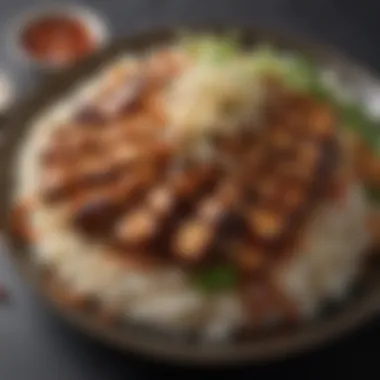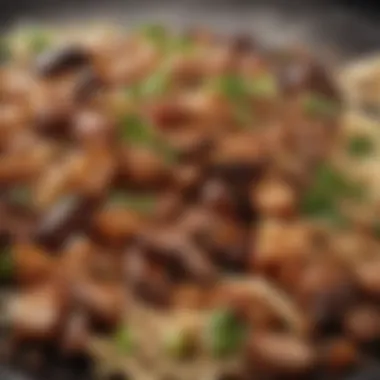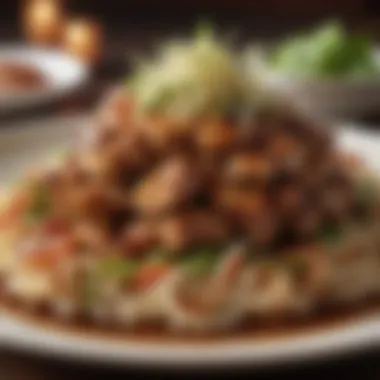Maui Teriyaki: Discovering Its Culinary Heritage


Intro
Maui teriyaki represents a unique blend of flavors and cultural significance, rooted deeply in the culinary traditions of Hawaii. This dish, while simple in its core components, reveals layers of history and culinary art that speak to both its origins and its evolution. For enthusiasts and professionals alike, understanding Maui teriyaki involves exploring its key ingredients, preparation methods, and the variations that present themselves across different regions and kitchens.
The joy of tasting Maui teriyaki extends beyond the plate. It invites us to consider the cultural narratives that accompany food. In this exploration, we will dissect the elements that contribute to its distinctive taste, the relevance in contemporary cuisine, and discover why it has become an emblem of Hawaiian culinary artistry.
By venturing into the depths of Maui teriyaki, we aim to provide a thorough appreciation of this beloved dish, examining its journey from traditional roots to modern culinary scenes. Through this, we will engage with the honest craftsmanship that prevents the dish from being mere sustenance but rather a celebration of flavors that has stood the test of time.
Prolusion to Maui Teriyaki
Maui teriyaki holds a special place within the culinary landscape of Hawaii, effortlessly blending sweet and savory flavors. This section explores what makes Maui teriyaki significant. Understanding its characteristics and history is critical for appreciating this dish.
Maui teriyaki is not just a meal; it embodies cultural interactions and local creativity. This dish invites diners to enjoy flavors that come from a long-standing tradition of cooking in Hawaii. In a world where food often connects to identity, Maui teriyaki represents a fusion of influences, particularly from Japanese cuisine.
Definition and Characteristics
Maui teriyaki is a style of cooking that often features grilled or seared proteins glazed with a unique teriyaki sauce. The sauce itself is a harmonious blend of soy sauce, sweeteners, and other ingredients that provide depth of flavor. This combination results in a finished product that is both shiny and appetizing.
The characteristics of Maui teriyaki can be summarized as follows:
- Flavor Profile: The balance of sweet and salty creates a complex taste.
- Texture: Grilled proteins have a nice char, contrasted by a sticky coat from the sauce.
- Versatility: Though often associated with chicken and beef, it can be made with various proteins and even vegetables.
Brief History and Cultural Context
The origins of teriyaki date back to Japan, where it was developed as a cooking method. As Japanese immigrants settled in Hawaii, they brought their culinary techniques, allowing teriyaki to evolve in a new environment. In Hawaii, local ingredients became integrated into the preparation of teriyaki, creating a unique version that reflects both Japanese and Hawaiian heritage.
By the late 20th century, Maui teriyaki, particularly, began to gain popularity outside of Hawaiian islands. It symbolized a broader trend of fusion cuisine, celebrating the cultural tapestry that defines Hawaii today.
"Maui teriyaki is a culinary story that transcends borders, presenting flavors that tell centuries-old tales of immigration and adaptation."
As food lovers explore Maui teriyaki, they engage not only in tasting flavors but also in understanding shared histories. This context enriches the overall experience, turning a simple meal into a cultural exploration.
In summary, understanding Maui teriyaki involves grasping its definition and appreciation of its historical roots. These elements form the foundation for a deeper dive into its ingredients and preparation methods in the following sections.
Key Ingredients
Understanding the key ingredients in Maui teriyaki is crucial for appreciating its depth of flavor and cultural significance. Each element contributes not only to the taste but also to the texture and appearance of the dish. Balancing these ingredients is essential to achieving that authentic Maui teriyaki experience.
Understanding Teriyaki Sauce
Teriyaki sauce serves as the backbone of Maui teriyaki. This sauce provides the fundamental flavor profile that defines the dish.
Soy Sauce
Soy sauce is the primary ingredient in teriyaki sauce. It brings in umami, which enhances the overall taste. Made from fermented soybeans, soy sauce has a salty flavor that balances perfectly with other sweet components. Its dark color also adds an appealing hue to the dish.
However, one must be mindful of the sodium content in soy sauce. Low-sodium varieties are also available, catering to health-conscious consumers without sacrificing flavor.
Sugar and Sweeteners
Sugar is essential in teriyaki sauce, balancing the saltiness of soy sauce. It contributes to the glaze that coats the protein, adding delightful sweetness. Depending on the preparation, some may use honey or alternative sweeteners, which introduce unique flavors.


A significant aspect of sugar is its caramelization during cooking, which adds a rich depth to the dish. Yet, excessive sugar can lead to an overly sweet profile, so moderation is key.
Mirin and Sake
Mirin is a sweet rice wine that adds complexity. It not only enhances sweetness but lends a distinct depth to the sauce. Sake, on the other hand, brings an aromatic quality that enriches the overall flavor.
Together, mirin and sake help in fluidity and blending of flavors. They contribute to the velvety texture of the sauce. It is important to avoid overuse, as their alcoholic content can alter the intended taste if not properly accounted for in the cooking process.
Ginger and Garlic
These two ingredients add a fresh, aromatic quality to the marinade. Ginger brings warmth and a slight spiciness, while garlic contributes a robust, savory note. Together, they create layers of flavor that elevate the dish.
Both are known for their health benefits and can also enhance the sensory experience while eating. Care must be taken not to overpower the sauce, as their strong flavors can dominate the palate if used excessively.
Protein Options
Choosing the right protein is vital for achieving the desired mouthfeel and satiety in Maui teriyaki dishes. Common protein options include chicken, beef, and plant-based alternatives. Each type has its unique characteristics that influence the overall experience.
Chicken Teriyaki
Chicken teriyaki is a classic option favored for its juiciness and tenderness. This protein soaks in the teriyaki marinade easily, resulting in a flavorful dish.
The lightness of chicken makes it a popular choice among many, particularly those seeking a balance of flavors without overwhelming richness. However, care must be taken not to overcook the chicken, as it can lead to dryness.
Beef Teriyaki
Beef teriyaki offers a richer taste compared to chicken. The marbled cuts provide a satisfying mouthfeel, with a heartiness that many enjoy. Beef absorbs the teriyaki sauce flavors well, resulting in a savory dish that stands out.
Nevertheless, it's important to select appropriate cuts, as tougher pieces may not yield the best results. Finding the right balance between cook time and tenderness is essential for an enjoyable beef teriyaki experience.
Vegetable and Tofu Alternatives
For those preferring plant-based diets, vegetable and tofu alternatives present fantastic options. Tofu is versatile, absorbing flavors easily while providing a satisfying texture. Vegetables such as bell peppers and zucchini add color and nutrition.
These alternatives cater to diverse dietary needs, making the dish accessible. However, proper preparation is essential to ensure all elements harmonize well in terms of taste and texture.
Overall, selecting key ingredients with care can dramatically influence the quality and enjoyment of Maui teriyaki. They contribute to the dish's character, making it both delightful and memorable.
Preparation Techniques
The preparation techniques for Maui Teriyaki are fundamental to achieving the perfect balance of flavors and textures. The right methodology enhances the dish’s authentic taste and maximizes the enjoyment for anyone savoring it. Understanding these techniques not only improves the quality of your teriyaki but also allows for customization to fit personal preferences.
Marination Process
Marination plays a crucial role in the preparation of Maui Teriyaki. It involves soaking the protein in teriyaki sauce before cooking. This step not only infuses the meat with flavor but also tenderizes it, making every bite succulent. The recommended time for marination can vary. For chicken, a 30-minute soak can suffice, but richer proteins like beef benefit from longer marination, sometimes up to two hours. In contrast, vegetables or tofu only requires brief marination, around 15 minutes.
In addition to flavor, marinating allows for the development of a glaze when the food hits high heat during grilling or baking. This caramelization is essential, as it forms that coveted outer layer on the meat. Using fresh ingredients in the marinade, such as garlic and ginger, can also elevate the dish's profile significantly.
Grilling vs. Baking
When it comes to cooking methods, grilling and baking offer distinct benefits. Grilling is the traditional approach in preparing teriyaki. It imparts smoky flavors and can create appealing char marks. This method is highly effective for protein like chicken and beef. A hot grill allows for quick cooking, which retains precious juices and avoids dryness.
On the other hand, baking provides an even cooking temperature, reducing the risk of overcooking. This method is particularly beneficial for those who prefer a hands-off approach or have limited outdoor cooking facilities. A common recommendation is to bake teriyaki at 400°F, ensuring the meat cooks through while allowing adequate time for the glaze to develop. Each method has its enthusiasts, creating opportunities for experimentation and preference.


Plating and Presentation
Plating and presentation elevate the overall dining experience. In Maui Teriyaki, visual appeal is significant as it speaks to the dish's cultural richness. A thoughtfully arranged plate draws attention and creates anticipation.
To present teriyaki attractively, start with a bed of rice or quinoa. This acts as a base, and the white or lightly colored grains create a contrast with the rich, dark sauce of the teriyaki. Arrange the protein on top, allowing the sauce to drizzle over it. Adding colorful garnishes like green onions, sesame seeds, or even slices of fresh pineapple can enhance visual appeal.
In essence, the way food looks can enhance the dining experience. The more inviting the dish appears, the more enjoyable the meal becomes. As with all culinary pursuits, attention to detail in presentation reflects the care put into the entire preparation process.
"The art of cooking is not just about taste; it is also about how food is presented. A beautiful presentation enhances flavor satisfaction and creates a complete experience."
Mastering these preparation techniques can define one’s Maui Teriyaki. A knowledgeable approach to marination, coupled with an understanding of cooking methods and presentation, is essential for anyone looking to celebrate this iconic dish.
Popular Variations of Maui Teriyaki
Maui teriyaki has evolved over time, leading to numerous variations that reflect both local flavors and food trends. This section highlights the diversity and adaptability of this dish, which is vital for understanding its role in Hawaiian and modern cuisine. Exploring popular variations not only showcases cultural creativity, but also identifies different preferences among food lovers. It encourages culinary experimentation, allowing individuals to tailor dishes to their personal tastes while preserving the essence of tradition.
Maui Teriyaki Bowls
Maui teriyaki bowls are a favored choice for many due to their balance of flavors and textures. A typical bowl consists of grilled teriyaki protein, rice, and fresh vegetables. This combination makes it a wholesome meal or lunch option. Bowls are also customizable, allowing patrons to add or remove ingredients. The rice serves as a perfect base that absorbs the savory teriyaki sauce, enhancing the overall experience.
These bowls are not merely about sustenance; they represent the spirit of sharing and community. Often served in casual dining environments, they provide a convenient way for groups to enjoy a meal together. Because of the colorful presentation and ability to cater to various dietary needs, teriyaki bowls have gained traction in both Hawaiian restaurants and food trucks. Such versatility makes them an exemplary representation of Maui teriyaki's modern adaptations.
Teriyaki Burgers and Sandwiches
Another popular variation is the teriyaki burger. This dish blends classic American favorites with Hawaiian influences. The burger typically features a juicy patty soaked in teriyaki sauce, served on a soft bun. Toppings might include grilled pineapples, fresh lettuce, and even a creamy aioli. Such combinations illustrate the collaboration between different culinary traditions.
Teriyaki sandwiches also share a similar profile, offering a portable meal option. These sandwiches usually incorporate grilled proteins alongside fresh vegetables placed between slices of bread. Both burger and sandwich versions serve to satisfy cravings while being a fun departure from conventional options. By incorporating teriyaki, they extend the dish's reach beyond traditional dining, making it accessible for more casual settings.
Teriyaki with Local Ingredients
The incorporation of local ingredients into teriyaki dishes elevates the traditional recipe to new heights. The availability of unique produce and grains creates opportunities for improved flavors and authenticity.
Pineapple
Pineapple is a quintessential tropical fruit that adds a burst of sweetness to teriyaki dishes. Its acidic quality complements the savory elements of the teriyaki sauce. Pineapple is often grilled, deepening its flavor profile and enhancing the overall dining experience. This ingredient contributes a refreshing contrast to the richness of the sauce.
Due to its popularity, pineapple serves as a hallmark of many Maui teriyaki dishes. It stands out as a beneficial choice, appealing to both traditionalists and modernists. This component undoubtedly adds a unique touch, enriching the culinary landscape.
Macadamia Nuts
Macadamia nuts are another local ingredient that enhances Maui teriyaki. Their creamy texture and rich flavor make them an intriguing addition. Often used as a topping or mixed into rice, macadamia nuts introduce a satisfying crunch and enjoyable differentiation in taste. They can elevate the overall dish, providing nutritional benefits as well.
As a popular choice, macadamia nuts support the theme of local integration within Maui teriyaki. However, they may not appeal to all due to dietary restrictions. Incorporating them can lead to a more complex dish if balanced with other ingredients.
Local Vegetables
Local vegetables are essential in Maui teriyaki, providing freshness and nutritional value. Seasonal produce adds visual appeal and nutritional benefits, while also allowing chefs to innovate based on availability.
Typically, vegetables like bok choy, bell peppers, and zucchini are cooked alongside the protein. They complement the dish, offering color and a touch of crunch. The key characteristic of local vegetables is their ability to absorb the teriyaki sauce while retaining their individual flavors. Such adaptability highlights their advantages in enhancing the overall culinary experience.
Overall, the variations of Maui teriyaki demonstrate its adaptability to local tastes and preferences. This exploration shows not just how diverse the interpretations can be, but also how the dish remains rooted in tradition while embracing innovation.
Nutritional Aspects of Maui Teriyaki


Understanding the nutritional aspects of Maui teriyaki is crucial for anyone wanting to appreciate this dish beyond its delicious flavor profile. As a staple in Hawaiian cuisine, it embodies a balance of taste and nutrition that appeals to a wide range of food enthusiasts. Nutritional considerations highlight how Maui teriyaki can fit within various diets while also examining its health benefits and drawbacks. This section outlines key components of the dish's nutritional value and suggests possible modifications for health-conscious diners.
Caloric Content and Macronutrients
Maui teriyaki, typically served with rice and protein, presents a nutritional composition that can vary based on the protein choice and added ingredients. On average, a standard serving of chicken teriyaki with rice can range between 400 to 600 calories. The primary macronutrients include:
- Proteins: Depending on the protein source, chicken provides around 30 grams of protein per serving, while beef might offer a similar or slightly higher amount.
- Carbohydrates: The rice component adds carbohydrates, usually around 45-60 grams, which provides energy.
- Fats: The dish may contain about 10-20 grams of fat, primarily from the cooking oil or fatty cuts of meat used.
Nutrition plays an important role in enhancing the culinary experience. Understanding what is in the food we eat can lead to better health choices.
The nutritional values of Maui teriyaki can shift significantly depending on the ingredients and cooking method. For instance, using less sugar in the teriyaki sauce can lower overall caloric intake while maintaining flavor.
Healthy Modifications
To enjoy Maui teriyaki while being mindful of health, several modifications can be made without sacrificing taste. Here are some considerations:
- Lean Protein Choices: Opt for skinless chicken breast or tofu instead of higher-fat cuts of meat. This reduces fat content while still providing protein.
- Whole Grains: Substitute white rice with brown rice or quinoa for additional fiber and nutrients. Whole grains can enhance satiety and support digestive health.
- Reduced Sugar in Sauce: Consider making a homemade teriyaki sauce with lower sugar content. This can be achieved by using natural sweeteners like honey or reducing the overall amount of sweet components.
- Vegetable Additions: Increase the vegetable content by adding steamed broccoli, bell peppers, or snap peas. This not only adds vitamins and minerals but also enhances the dish's volume with fewer calories.
By making these small yet significant adjustments, diners can enjoy a nutritionally balanced version of Maui teriyaki that aligns with their health goals.
Maui Teriyaki in Popular Culture
Maui Teriyaki has become a prominent symbol within the Hawaiian culinary landscape. Its influence extends well beyond the traditional plate, embedding itself in the cultural fabric of Maui and its representation in contemporary food trends.
Maui Teriyaki in Restaurants
The popularity of Maui Teriyaki in restaurants showcases its versatility and appeal. Various dining establishments across Maui and other regions have embraced this dish. Many restaurants offer unique twists while maintaining the essential flavors.
- Local Eateries: Many small, family-owned restaurants offer authentic Maui teriyaki, usually prepared with locally sourced ingredients. These establishments often highlight Hawaiian culture, blending tradition with modern tastes.
- Fast Food Chains: Some fast-casual restaurants have included Maui teriyaki bowls or wraps, catering to a broader audience. They modify the traditional recipe to meet urban lifestyles, yet retain the signature flavors.
- Gourmet Variations: High-end restaurants have also incorporated Maui teriyaki into their menus, presenting it as an elegant dish with plating that reflects upscale dining standards.
Each of these settings contributes to a growing recognition of Maui teriyaki, elevating it from a regional dish to a culinary favorite enjoyed by a wide array of diners.
Influence on Modern Hawaiian Cuisine
Maui teriyaki greatly influences the broader context of modern Hawaiian cuisine. As chefs experiment with flavors and textures, they integrate Maui teriyaki elements into various dishes.
The approach to using traditional ingredients in new ways exemplifies this movement. For example, you'll find teriyaki-glazed seafood or fusion dishes that incorporate Maui teriyaki's sweet and savory profile.
- Crossover Dishes: Dishes like teriyaki tacos or sushi rolls highlight the adaptability of Maui teriyaki in the food industry.
- Ingredient Innovation: Many chefs increasingly emphasize local ingredients, like fresh vegetables and tropical fruits, alongside traditional teriyaki components. This integration helps to redefine what Hawaiian cuisine represents.
"Maui teriyaki serves as a portal to a unique culinary tradition that continues to evolve, reflecting not only its roots but also the influences of modern dining trends."
In summary, Maui teriyaki not only resonates in restaurants but also plays a significant role in shaping modern Hawaiian cuisine. It creates pathways for innovation while honoring cherished traditions.
Ending
The exploration of Maui teriyaki reveals its significant place within culinary arts. This dish is more than just a meal; it encapsulates a rich history and diverse flavors that resonate with both locals and visitors to Hawaii. Understanding its components offers insights into the cultural heritage of the islands, blending traditional seasoning and modern gastronomic trends.
Summary of Key Takeaways
- Cultural Significance: Maui teriyaki represents Hawaiian culture and its fusion with Japanese influences. The combination of different traditions contributes to its unique taste and presentation.
- Key Ingredients: The article highlights essential components like soy sauce, ginger, and garlic. Each adds depth to the overall flavor profile, emphasizing the importance of quality in preparation.
- Variations and Adaptability: Variants such as teriyaki bowls, burgers, and the use of local ingredients enhance the dish's versatility, making it accessible for various diets and preferences.
- Health Aspects: With awareness growing around nutrition, modifications can be made to traditional recipes to make them lighter without losing authenticity.
- Culinary Influence: Maui teriyaki influences modern Hawaiian cuisine, encouraging chefs to innovate while respecting tradition.
Future Trends in Maui Teriyaki
As culinary landscapes continue to evolve, Maui teriyaki is expected to adapt and grow. Some potential trends include:
- Health-Conscious Alternatives: There will likely be an increase in lighter options, such as the use of plant-based proteins and low-sugar sauces to appeal to health-focused diners.
- Global Fusion: The incorporation of global culinary techniques and flavors may result in unique dishes that maintain the essence of Maui teriyaki while exploring new horizons.
- Sustainability Emphasis: Sourcing local and sustainable ingredients will become more important, aligning with broader food industry trends toward environmental responsibility.
- Culinary Tourism: As interest in Hawaiian culture grows, more food tourists may seek authentic experiences centered around dishes like Maui teriyaki. This could lead restaurants to innovate how they present this dish to cater to evolving tastes and curiosities.
Overall, the study of Maui teriyaki exemplifies how food transcends mere sustenance. It fosters understanding of cultural connections and culinary creativity, ensuring that this dish remains a beloved staple for years to come.







